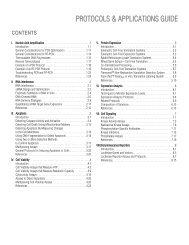2012 Promega catalogue
2012 Promega catalogue
2012 Promega catalogue
You also want an ePaper? Increase the reach of your titles
YUMPU automatically turns print PDFs into web optimized ePapers that Google loves.
Cell Signaling<br />
Cell ID System<br />
Product Size Cat.# Price ($)<br />
Cell ID System 50 reactions G9500 Pls. Enq.<br />
Available Separately<br />
Water, Amplification Grade 6,250 µl DW0991 Pls. Enq.<br />
Internal Lane Standard 600 150 µl DG1071 354.00<br />
DW0991, DG1071 For Laboratory Use. G9500 For Research Use Only. Not for Use in Diagnostic<br />
Procedures.<br />
Description: The Cell ID System provides the reagents required for successful<br />
and simple identification and authentication of human cell lines and<br />
detection of intra-species cell line cross-contamination. The Cell ID System<br />
uses short tandem repeat (STR) analysis of specific loci in the human genome<br />
through co-amplification and three-color detection of ten loci (nine STR loci and<br />
Amelogenin for gender identification), including D21S11, TH01, TPOX, vWA,<br />
Amelogenin, CSF1PO, D16S539, D7S820, D13S317 and D5S818. All ten loci<br />
are amplified simultaneously in a single tube. The Cell ID System includes a<br />
hot-start Taq DNA polymerase in an enzyme mix for convenient room-temperature<br />
reaction assembly. Alleles, along with the allelic ladder and an internal lane<br />
standard that assists in assigning sizes for each of the loci, are resolved by<br />
capillary electrophoresis in a single injection, and CE data are analyzed using<br />
allele-calling software to generate a genetic profile of the cell line. These loci<br />
collectively provide a genetic profile with a random match probability of 1 in<br />
2.92 × 10 9 .<br />
The Cell ID System is designed specifically for use with the Applied Biosystems<br />
3130 and 3130xl Genetic Analyzers, ABI PRISM ® 3100 and 3100-Avant<br />
Genetic Analyzers and ABI PRISM ® 310 Genetic Analyzer.<br />
Dye matrix generation is required on initial setup and is performed using the<br />
PowerPlex ® Matrix Standards, 310 (Cat.# DG4640), or PowerPlex ® Matrix<br />
Standards, 3100/3130 (Cat.# DG4650).<br />
For complete and up-to-date product information visit: www.promega.com/catalog<br />
Features:<br />
• Improved “Gold Standard” STR Analysis: The Cell ID System<br />
includes all loci used in the original PowerPlex ® 1.2 System plus the<br />
D21S11 locus for improved power of discrimination.<br />
• Simplified Data Interpretation: The Cell ID System allows coamplification<br />
of 10 loci to accurately discriminate between human cell<br />
lines without using a full forensic profile and includes allelic ladders for all<br />
10 loci to simplify data interpretation.<br />
• Simplified Amplification Setup: Inclusion of a hot-start Taq DNA<br />
polymerase allows room-temperature reaction assembly.<br />
• Internal Lane Standard 600 Included: This marker offers the greatest<br />
precision available for DNA typing. It is designed for use in each capillary<br />
injection to increase the precision of your analyses.<br />
• Automatic Assignment of Genotypes: To make genotyping easier and<br />
more accurate, panels and bins text files are available for download and<br />
are required for use with GeneMapper ® ID software. GeneMapper ® 4.0<br />
software requires custom bin generation.<br />
Storage Conditions: Store at –20°C. The Primer Pair Mix, Allelic Ladder and<br />
Internal Lane Standard are light-sensitive and should be stored protected from<br />
light.<br />
Protocol Part#<br />
Cell ID System Technical Manual TM074<br />
Fluorescein:<br />
JOE:<br />
TMR:<br />
A<br />
D5S818<br />
CXR:<br />
Size (bp) 100 200 300 400<br />
A = Amelogenin<br />
TH01 D21S11<br />
D13S317 D7S820 D16S539 CSF1PO<br />
vWA TPOX<br />
Allele ranges for the Cell ID System. STR fragments amplified<br />
by the Cell ID System are labeled with different dyes and are<br />
separated by capillary electrophoresis based on size. A size standard<br />
is included in each sample to determine the sizes of the Cell ID-amplified<br />
fragments. Fluorescein-labeled loci are shown in dark gray, JOE-labeled loci<br />
are shown in gray and TMR-labeled loci are shown in white. The CXR-labeled<br />
Internal Lane Standard 600 fragments are represented by black bars.<br />
7426MA<br />
293<br />
17<br />
Stem Cell Research<br />
Section<br />
Contents<br />
Table of<br />
Contents
















